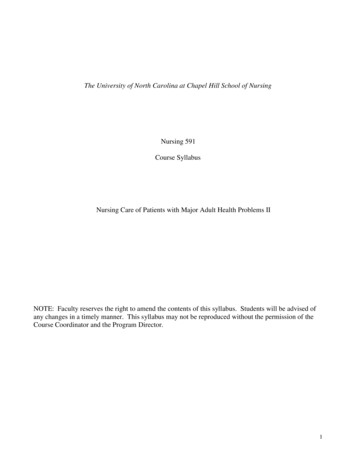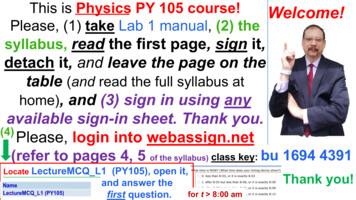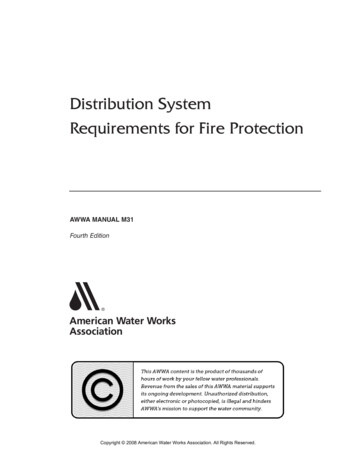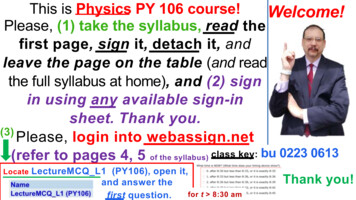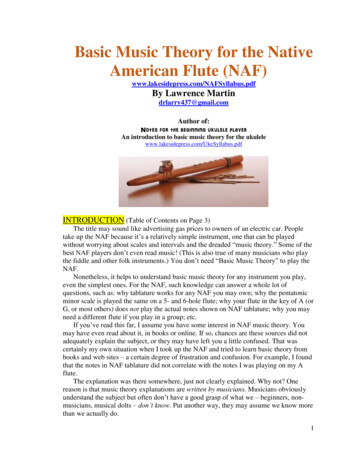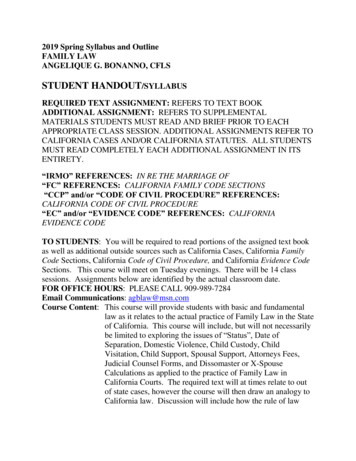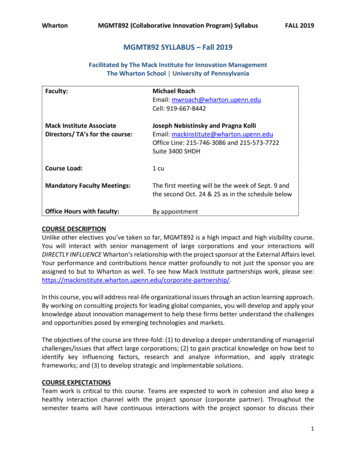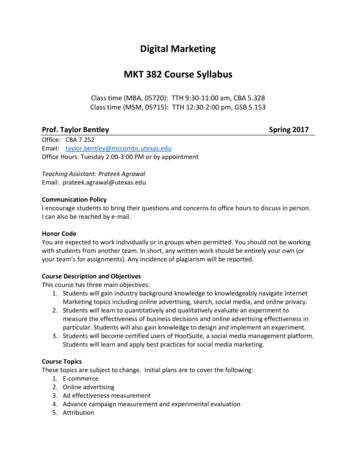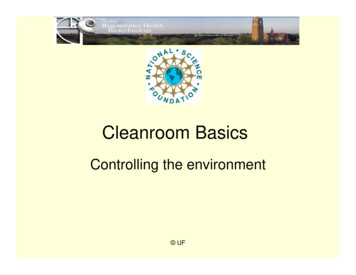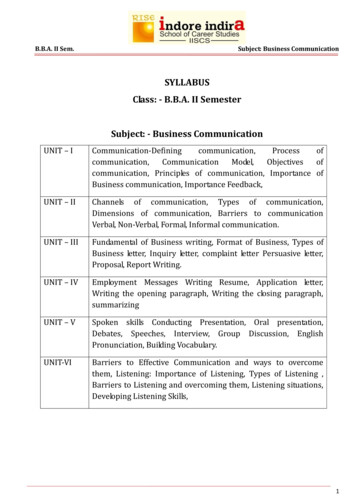
Transcription
B.B.A. II Sem.Subject: Business CommunicationSYLLABUSClass: - B.B.A. II SemesterSubject: - Business CommunicationUNIT – tion, Principles of communication, Importance ofBusiness communication, Importance Feedback,UNIT – IIChannels of communication, Types of communication,Dimensions of communication, Barriers to communicationVerbal, Non-Verbal, Formal, Informal communication.UNIT – IIIFundamental of Business writing, Format of Business, Types ofBusiness letter, Inquiry letter, complaint letter Persuasive letter,Proposal, Report Writing.UNIT – IVEmployment Messages Writing Resume, Application letter,Writing the opening paragraph, Writing the closing paragraph,summarizingUNIT – VSpoken skills Conducting Presentation, Oral presentation,Debates, Speeches, Interview, Group Discussion, EnglishPronunciation, Building Vocabulary.UNIT-VIBarriers to Effective Communication and ways to overcomethem, Listening: Importance of Listening, Types of Listening ,Barriers to Listening and overcoming them, Listening situations,Developing Listening Skills,1
B.B.A. II Sem.Subject: Business CommunicationUnit 1INTRODUCTIONThe word communication originates from the Latin word “communis”, which means “common” and the wordbusiness stands for any economic activity which is undertaken with a view to earn profit and thecommunication undertaken in the process of this activity is termed as "business communication.DEFINITIONCommunication is a process of passing information and understanding from one person to another.Keith DevisCommunication is generally defined as the activity of conveying information. Communication has been derived from theLatin word "communis", meaning to share.WikipediaCommunication is something people do. To understand human communication process, one must understandhow people relate to each other.Wilbur SchrammMEANINGCommunication is defined as “The flow of material information perception, understanding and imaginationamong various parties”.Business includes those organizations, which are engaged in the production and distributionof goods and services to earn profit. Therefore Business communication means, “Flow of information,perception etc. either within a business organization or outside the organization among different parties”.OBJECTIVES &PURPOSE OF COMMUNICATIONThe objectives of business communication would include the following:To give and receive informationTo provide adviceTo educate and train customerTo issue orders and instructionTo persuade target audienceTo receive suggestionTo motivate and to integrateTo relate and to entertainImportance of Business CommunicationPersuasion is one of the factors of marketing communications. Persuasion is the main reasoncompanies engage in marketing: to persuade their target audience to take action, as in, buy theirproduct or subscribe to their services, make a phone call, or donate money.All marketing communication is goal oriented, as the predetermine objective helps to create effectivemarketing communication strategy.Every successful marketing communications helps plan the marketing message at every contact pointthat are received by the target audience.It facilitates in controlling the performance and take necessary remedial actions on the basis offeedback information from them.Communication creates a meeting of minds and improve industrial relations. It helps to developmutual co-operation and understanding thereby improving industrial productivity.Communication is indispensable for every organization to develop and maintain reputation orgoodwill with its customers, investors, dealers, suppliers etc.Principles and Nature of CommunicationsA business Organization is a group of people associated to earn profit. Various kinds of activities have to beperformed by the people of an organization so as to earn profit. Business Communication is know n as backbone of any Organization thus various activities in business need an effective and systematic communication.2
B.B.A. II Sem.Subject: Business CommunicationWithout efficient communication, one cannot even imagine to do work and hence will be unable to earnprofit. Since the aim of business organization is to earn profit, the organization will die without profit andthis death is a result of the absence of communication. This is why communication is called life blood of abusiness organization. We can prove this statement more clearly through following points.Gain clarity over - WHO? WHERE? WHAT? HOW MUCH? FORM, CHANNEL, PERIOD and WHAT WASIT?Communication involves plurality of personsExistence of message is essential which may be the orders, instructions or information about themanagerial plans, policies, programmesIt’s a two way and continuous processIts primary purpose is to motivate a responseCommunication may be formal controllable or informal uncontrollableIt can be in vertical, horizontal or diagonalThe Seven Cs of Communication help overcome barriers:1.2.3.4.5.6.Consideration: consideration states that every message should be prepared keeping in mind the personwho will be the receiver of the message. Receiver's interest should be kept in mind while drafting themessage. Specific ways to indicate candidness are: Focus on "you" attitude instead of "I" on "We"Material or content of the message should be from reader's point of view.Use of positive words should be allowed so that positive reaction could be received by the readers.Benefits of readers should be the prominent part of message.Examples:We Attitude: I am delighted to announce that there will be extra classes for the students in college to clarifytheir problems.You Attitude: You will be able to clarify your problems in the extra classes organized in college.Clarity: Clarity is most important characteristic of communication especially in case or oralCommunication/Presentation. Clarity in words, language of expression is very important to ensure properpresentation of ideas, message one wants to communicate during conversation.Clarity can be achieved through following ways:Precise, familiar use of words or language during communication, Effective sentences should be framed,There should be unity in all one words of message so that the main idea of message can be properlycommunicated.Short length sentences of average 17 to 20 words should be preferred.Completeness: Complete message is very important to communicate the main idea or information behindthe message. Oral presentations should be as far as possible planned on restructured and all the informationrelated to message should be properly communicated.Guidelines for ensuring completeness are as follows:Provide all necessary information required for accurate understanding of message.All Questions asked by the audience should be properly answered by presenter during oralpresentation/communication.Some extra information when ever desirable should be given to audience to make the presentation topicmore clear, specific of complete.Conciseness: Conciseness is the essential requirement of oral communication. Concise message savestime on expense for both sender on receiver concise means brief, short on informative message which is ableto explain the idea of message with minimum words. Words in message should not be repetitive in nature &only relevant information should be communicated in message.Correctness: In oral communication grammatical errors should be avoided. Right level of language shouldbe used both in formal & informal communication. Use of accurate words and spellings should be considered.Concreteness: it means specific, definite on valid use of information than vague or general. Concrete factson figures should be used to make the receivers know exactly what is required or desired. Concrete language3
B.B.A. II Sem.Subject: Business Communicationon information helps in interpreting the message in same way as communicate intend to communicate themessage.7.Courtesy: A proper decorum of speaking should be maintained while making oral communication/presentation. One should say things with force of assertive without being rude. Polite or humble languageshall be used which should not be insulting, against the religious, social as personal values of listener.Discriminatory language based, on gender, race, age, colour, cost creed, religion etc should be avoided.1.2.3.4.5.6.7.8.ELEMENTS IN COMMUNICATIONSender:Someone who is sending the message to someone lese. For example, in ad the brand being advertised is‘Pantaloons’. Naturally, the maker of this brand is the sender of the advertising message.Encoding:When we address someone, we use language, visuals, body gestures, etc. to communicate. All these are calledsymbols. The process of putting our thought into symbolic forms is called encoding. In a following Ad, you seea face full of wrinkles. Then you read the headlines which simply say: “Wrinkle free.” This process ofcommunication is called encoding.Message:The symbols themselves constitute the message. Hence, the visuals, headlines body copy, tag line, brandname, logo, etc., are all parts of the message. If you have already heard the name of ‘Pantaloons’, then themessage being given to you is that are dealing with a known company.Media:The channels used for sending the message across to the receiver (customer) is called medium (or media;note that media is also singular). This Ad has appeared in the print media (just for the sake of knowledge, TVis an audio-visual medium, radio is an audio medium, etc. You will learn more about media in the secondyear). An individual member of the medium is called a vehicle. Here, India Today is the vehicle. A vehicle is thecarrier of the message.Decoding:Once we receive the message, we start interpreting it. For example, when you look at the wrinkled face shownin the Ad, you realize how bad it looks. The implication is that your clothes will also look as bad if they werenot wrinkle free. Likewise, there are visuals of a shirt and a pair of trouser. These immediately give you themessage that the Ad is perhaps for readymade clothes. At the bottom, the message given is that the brand isavailable at various cities and Pantaloon Shoppes.Receiver:A receiver is one who reads/listen hears the message of the communicator. For example, any reader of IndiaToday who is likely to see this Ad, is the receiver of the message. It may be noted, however, that thecommunicator (in our example, the manufacturer of Pantaloons) is not interested in just any receiver (i.e. anyreader of India Today) but only those who would be interested in using his product. Thus, if never weartrousers, then the company will not be interested in me.Response:After having read the ad, I will react to the message. My reaction (alternatively known as response) could beobjective (if I accept what the sender of the message is saying) or negative (If I don’t accept the message). Forexample, the body copy in the Ad says: “Pantaloons presents T 2000 .” I may get impressed by the fact thatthe range has T 2000 choices available! But I may also reject the claims made in the body copy in case I findthem unbelievable.Feedback:Every communicator waits to know whether the message (a) has reached the target audience or not, and (b0whether it has been accepted or not. In other words, one waits for feedback from the audience. The mostdesirable form of feedback from the marketer’s point of view, of course, would be the purchase of the productby the customers. Thus, after this Ad is released in the media, if the sale of such trousers goes up significantly,the feedback is said to be positive. Similarly, if the company conducts a surveys and questions about theintention to buy; and customers say that they will buy the brand, again, the feedback is positive.PROCESS OF COMMUNICATIONThe process of communication involves two or more persons participating through a medium that carries the4
B.B.A. II Sem.Subject: Business Communicationinformation or message for a particular purpose which is mutually understood by both the sender andreceiver. Only when these conditions are fulfilled, a significant communicative situation will take shape4. Noise(Physical and Psychological Distraction1.Source(Encoding)2.Message andcontent3. CommunicationChannel media TV.Radio, Newspapers,Magazines, Internet,Mail, Phone5.Receiver(Decoding)6. Feedback-InteractivityImmediate ResponseDelayed ResponseNo ResponseThe receiver is anyone who is exposed to a message. Once receiver, receive a message, they decode it.Decoding is the process of interpreting what a message means. After customers decode a message, theyrespond in some way, indicating to what extent the message was received, properly decode, and persuasive.This response is called feedback, which is a response that conveys a message back to the source.The communication process occurs in a context or environment where other things are going on-competitivebrand message, people walking by, a telephone ringing, as well as thoughts inside customers’ heads. These“other things” are called noise-interferences or distractions that can negatively affect the transmission andreception of a message.FEEDBACK AND MEASURING COMMUNICATION RESULTSAfter implementing the communications plan, the communications director must measure its impact on thetarget audience. Members of the target audience are asked whether they recognize or recall the message,how many times they saw it, what points they recall, how they felt about the message & their previous ¤t attitude towards the product & the company. The communicator should also collect behavioralmeasures of audience response such as how many people bought product, liked it & talked to others about it.COMMUNICATION MODELSSHANNON WEAVER MODELIn 1948, Shannon was an American mathematician, Electronic engineer and Weaver was an Americanscientist both presented this model. It was specially designed to develop the effective communication betweensender and receiver. Also they find factors which affecting the communication process called “Noise”. At firstthe model was developed to improve the Technical communication. Later it’s widely applied in the field ofCommunication.5
B.B.A. II Sem.Subject: Business ERACTIVE MODELWith slighter change in Shannon weaver model, the interactive model can me developed. Feedback is anavoidable stage in communication by introducing this phase to the above model we get interactive model ofcommunication which is as INTERMEDIARY MODELAn intermediary model of communication was developed by Katz and Lazarsfeld in 1955. it focuses on theimportant role held by the intermediaries in the communication process. Many of these intermediaries havethe ability to decide and influence the messages, the context and ways in which they are seen. They often havethe ability, to change messages or to prevent them from reaching an audience.TRANSACTIONAL MODELThe transactional model of communication takes into account noise or interference in communication aswell as the time factor. The outer lines of the model indicate that communication invalves both systems ofcommunicators and personal systems. It also takes into account changes that happen in the fields ofpersonal and common experiences. The model also labels each communicator as both sender as well asreceiver simultaneously. There is this interdependence where there can be no source without a receiver andno message without a source. Communicators depends on factors like background, prior experiences,attitudes, cultural beliefs and self-esteem.6
B.B.A. II Sem.Subject: Business CommunicationModels of CommunicationThere are many communication models to understand the process involved in it as developed by differenttheorists two types of models are –1. Linear Models and2. International or Interactional modelsAccording to Aristotle in a communication event, there are three main ingredients, such as:1. The speaker2. The speech and3. The audienceSubsequently, a number of experts have developed modern models of communication which are more complexand dynamic.Shannon and Weaver ModelThey considered the theory as strictly mathematical can has been identified with technology and technicalaspects of communication. They considered communication as a mechanistic system consisting of thefollowing five basic elements. They are1. Information – Source2. Transmitter – to convert a message into transmittable signals3. A channel4. A Receiver – Who reconstructs the message from the signals5. Destination – The person or machine to whom it is intendedthe other four components, he introduced in the system, are –1. The message3. Received Signals2. Transmitted Signals4. Noise SourceThe degree of difference in meaning between the sender and the receiver is accounted for by noise. Themathematical theory of communication is also used in developing the information and computer science.7
B.B.A. II Sem.Subject: Business CommunicationDavid K. Berlo's ModelBerlo's model is of basic importance in developing other communication models and for Identifying elementsof communication. Berlo's process theory has contributed a great deal to the subject of communication.The following nine components are included in his model:A SourceA EncoderA MessageA ChannelA ReceivedA DecorderA MeaningA FeedbackA NoiseFig. David K. k Berlo's MoldHarhold D.Lasswell ModelThe communication process of Lasswell, in its broader analysis, gives rise to four basic and importantquestions. They are Who? What? Whom? Which? The behavioural aspect of the sender in the communicationprocess is well-established by Lasswell. But his model ignores the essential elements of the communicationprocess.INWHOMEDIASender10 WHOMSAYS wAturRECEIVERINTERPERSONAL OR INTERACTIONAL MODELFeedback with reference to the communication process means interaction or interface or face-to-lacecommunication with another person who is the receiver of the message. The purpose feedback is to measureand evaluate the message received by the receiver and to plan for future communication. Thus, feedback mayresult in revision or alteration of the original message or sending altogether a new message.It is necessary to have interaction between the sender and the receiver. This has given rise to interpersonalor interactional model of communication. It is the interaction which facilities the return information calledfeedback. This may be effective by the words, signs of behaviour change. By this, the cycle or circular flow ofthe words, sing or behaviour change. By this, the cycle or circular how of communication is complete. This istwo-way communication or international or international is complete. This is two way communication orinterpersonal model. The linear model is known as one-way communication. This is the reason why effectivecommunication is called interpersonal or interactional communication.The interpersonal model of communication demands the presence of the following elements in the process ofcommunication;1. Message or idea or stimulus2. Sender or transmitter or communicator3. Encoding4. Channel5. Medium6. Receiver7. Decoding8. Action or behaviour change9. FeedbackEssentials of Good Communication – Seven C’s of Communication1. Clarity: - Clarity of idea, facts, and opinion in the mind of communication should be clear beforecommunication. It is a thinking process to conceive the subject.8
B.B.A. II Sem.Subject: Business Communication2. Information: - All communication contains information while all information cannot communicate amessage.3. Completeness:- The subject matter to be communicated must be adequate and full so that receiver'get the message.4. Emphasis on Attention: - communication is one in which receiver interest is created and they shouldpay proper attention to the message.5. Consistency:- The message transmitted should not be contradictive6. Simplicity:- Avoid using superfluous words Unnecessary prepositions, jargon.7. Follow up on Communication:- The language should be simple & only common words be used.8. Support wards with deeds9. Be a good listener10. Credibility:11. Context: The communication program must square with the qualities of its environment.12. Content: - The message must have meaning for the receiver.13. Capability:- Communication must take into a Count the capability of the audience.14. Channels:- Channel of communication should be use according to receivers respects9
B.B.A. II Sem.Subject: Business CommunicationUnit - IIDirection of CommunicationDownward CommunicationThe communication is said to be downward when it flows from the top to the bottom. In the levels ofmanagement, from top to bottom means the flow of communication from the superiors to subordinates.When information comes from higher level in the organization structure, it is termed as downwardcommunication.Objectives of Downward Communication1. Information2. Instruction3. Requests4. Advice5. CounselingProblems of Limitations of Downward Communication1. Filtration of Messages2. Misunderstandings and confusion3. Reliability of the source4. Overload of Message5. Timing6.7.8.9.10.PersuasionWarning and NoticeAppreciationMotivationRaising Morale6.7.8.9.Rely on written MediaLack of Trust and ConfidenceLack of FeedbackRigidityUpward CommunicationIt is opposed to downward communication. A communication is Said to be upward when it moves from thebottom the top. In the organizational structure, from the bottom to top means the flow of communicationfrom Subordinates to superiors. Whenever information moves form a lower to higher level in theorganization, is termed "upward communication." Upward communication may transmit either by oral mediaor written media.Objectives of Upward Communication1. Reports2. Information3. Requests4. Appeals5. sImportance of Upward Communication1. Upward communication provides useful information, data etc., which are more useful for decisionmaking.2. This channel serves the growth and development of democratic leadership.3. It motives and encourages work spirit to active workers. The motivation is essential for improved andefficient working of an organization4. It promotes loyalty, honesty and participative attitude so essential for effective functioning.5. Under this system of communication, idea of the subordinates cannot be obtained without encouragingupward communication.6. Effective communication channel flow upward essentially, provides the manger with the information ofwhat the subordinates are doing, highlights of their Work, achievements, progress, and future job plans.7. This channel serves as a useful channel because it deals with work centered matters about which thealert executive normally tries to keep himself well informed;8. Effective communication upward channel conveys feelings about the job, feelings about their, feelingsabout the company.9. It provides scope which may be valuable to spell out in detail some of the things an executive should learnthrough upward channel.10. It facilitates an effective in built feedback mechanism particularly feedback in the case of writtencommunication.10
B.B.A. II Sem.Subject: Business Communication11. It gives an opportunity to present an improved picture of what subordinates think of the willingness, ofthe superiors to discuss politic; Plans and actions.Limitations of Upward Communication1. Fear2. Distrust of Superiors3. Lack of Common Sharing4. Long Chain of Command5. Lack of Ability6.7.8.9.10.Lack of confidence in SuperiorsFear of CriticismLack of Self Confidence and IncentivesNon-listening AttitudeDistanceHorizontal CommunicationIt is the flow of information between person of the same hierarchical level. Formal organization provides forhorizontal communication by means of right of persons at any level to consult or work with others at thesame level.Importance of Horizontal Communication1. Co-ordination2. Problem Solving3. Conflict Resolution4. Communication by Objectives5. Effective Control6. Speed Flow7. Useful to Subordinates8. Balance Downward and Upward9. Limitations,Creates ConfusionLeads to DisruptionCreates ConflictsIntroductionThis involves inter —departmental communication by people at different levels. It is rarely used. A goodexample could be a project team dream from different grades of departments.It involves communication, between two different organizational levels. Research has shown thatmanagers spend a large portion of each day involved is diagonal communication.Greater the interdependence of various departments within the larger organizations, the greater thenecessity for such diagonal communication message transfer.The growing complexity of the modem business structure has necessitated the creation and growth ofdiagonal communication.Since diagonal Communication violates the traditional top bottom, bottom, - up forms oforganizational they often disrupt the normal format of work.Subordinates Participating in these non-traditional communication forms; often become aware ofevents before the managers.Advantages of diagonal communication1. Spread information more quickly than the traditional forms of communication.2. Serve to link groups that otherwise would either have to communicate through the much slowerupward — downward organization communication channels or not communicate at all.3. Enable individuals with diverse knowledge is different parts of the organization to contribute toproblem solution, enhancing the effectives of resources use within the organization.Disadvantage of a diagonal communication —1. These interfere with the normal organizational routine, & they cannot be effectively controlled by the,organization.2. It leads to the formation of a grapevine.3. The staff members come to know about all the information even before it is circulated to their headsor superiors. .Introduction11
B.B.A. II Sem.Subject: Business CommunicationNon-verbal communication is the information that is communicated without the of words. It includesapparent behaviours such as, facial expressions, eyes, touch, tone of voice, as well as less obvious messagessuch as dress, posture spatial distance between two or more people.Commonly, non-verbal communication is learnt after birth & practiced and refined through a person'slifetime.Non verbal communication is use because1. Words have limitations2. Non-verbal signals are powerful3. Non-verbal messages are likely to be more genuine4. Non-verbal signals can express feelings in appropriate to state5. A separate communication channel is necessary to help Send complex messagesResearchers say that only 7%of message is sent through words, with remaining 93% sent through nonverbal expressions.The study of body motion as related to speech is known as kinesics. This includes –Mutual gaze *facial warmth or pleasantness* child like behavior* direct orientation, etc.The Role of Different Parts of the Body language in Communication is as Follows –1. Facial expressions - The egression tithe face is the most obvious aspect of body language.Expressions accompany the speaker s words and also indicate the listener's reaction.2. Eye contact - The study the role of eyes in non-verbal communication is sometimes referred to as'"oculesies". Eye contact can indicate interest, attention involvement.3. Gestures - A gesnue is a non-vocal bodily movement intended to express meaning. They may bearticulated with hands, arms or body, & also included movement of head, face. & eyes such as winking,nodding, or rolling ones eyes.4. Posture- It can be used to determine a participant’s degree of attention or involvement. Thedifference in status I men communicator & the level or fondness the person has for the communicator.Advantages of a Body LanguageIt is easy to understandIt is a support for verbal communicationIt puts life into communicationIt is a natural outcomeIt fills the gap createdPara LanguageIt refers to the non-verbal elements of communication used to modify meaning and convey emotions.Paralanguage may be expressed cautiously & incautiouslyIt includes pitch, volume, voice, tone.The study of paralanguage is known as paralinguistic.Audio SignsThe non-verbal communication in which the sounds are easily, recognized without verbal or visualcommunication. Like sirens, clarinets, flute, ambulance police jeep, train horn, etc.Visual SignsThe signs which are generally used so as to know the meaning which the sign identifies. The best examples12
B.B.A. II Sem.Subject: Business Communicationare the similes used during chatting in yahoo or other mails.Channel of CommunicationMeaning — Communication channel are established by the organization and are accepted & recognized byemployees & managers:External communication –Communication with those outside the organization is known as external communication.Outward- The messages which go out of the organization to customers, suppliers, banks, insurancecompanies, govt. departments, mass media & the general public. They may be in the form of letters,taxes, banners, reports, telegrams, advertisements, press handouts, speeches, visits, trade fairs, etc.Inward - messages that are received from outside by the company. An organization may receiveletters, faxes, telegrams, telephone calls, personal visits, magazines. etc., these may be, fromcustomers, suppliers, other organization, govt. departments, etc.Internal CommunicationThe communication within the organization, among its members is internal Communicationa) Formal channel — the communication when takes place within the official i.e. the lines ofcommunication is approved by senior management. This is the channel which carries the officialmessages in the organization.Under a formal channelThere are efforts made by each & every individual at various levels.The most important aspect of fo
B.B.A. II Sem. Subject: Business Communication 2 Unit 1 INTRODUCTION The word communication originates from the Latin word òcommunis ó, which means òcommon ó and the word busi

